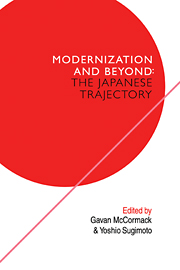Book contents
- Frontmatter
- Contents
- Contributors
- Introduction: modernization and beyond
- I Popular culture: tradition and ‘modernization’
- II Popular movements: alternative visions of ‘modernization’
- III Uneven development and its discontents
- IV Sex, politics and ‘modernity’
- V ‘Modernization’ and ‘modernity’: theoretical perspectives
- 13 Paths to modernity: the peculiarities of Japanese feudalism
- 14 The concept of modernization re-examined from the Japanese experience
- Glossary
- Index
14 - The concept of modernization re-examined from the Japanese experience
Published online by Cambridge University Press: 04 August 2010
- Frontmatter
- Contents
- Contributors
- Introduction: modernization and beyond
- I Popular culture: tradition and ‘modernization’
- II Popular movements: alternative visions of ‘modernization’
- III Uneven development and its discontents
- IV Sex, politics and ‘modernity’
- V ‘Modernization’ and ‘modernity’: theoretical perspectives
- 13 Paths to modernity: the peculiarities of Japanese feudalism
- 14 The concept of modernization re-examined from the Japanese experience
- Glossary
- Index
Summary
Classical sociology consists of social dynamics and social statistics. In social dynamics, the sociological dichotomy based upon the two-stage model of social development gained currency. The only notable exception was Auguste Comte who proposed a three-stage model of development where human knowledge develops from the theological through the metaphysical to the empirical stage and society correspondingly transforms from the militaristic through the legalistic to the industrial stage. Herbert Spencer advanced a two-stage developmental model from militaristic to industrial society. This type of dichotomous model is discernible in H.J.S. Maine's model of development from status to contract, in Ferdinand Tönnies' model from Gemeinschaft to Gesellschaft, and in Emile Durkheim's model from mechanical to organic solidarity.
Further, Max Weber who interpreted the change towards Gessellschaft as a process of rationalization suggested the transformation from traditionalism to rationalism as a major trend and put forth the notion of disenchantment. In this sense, he too follows the tradition of the sociological dichotomous model. Talcott Parsons' model of pattern variables is another case in point. To the extent that it was based on Tonnies' dichotomy of Gemeinschaft (community) and Gesellschaft (association), a developmental direction – (1) from affectivity to affective neutrality, (2) from particularism to universalism, (3) from functional diffuseness to functional specificity, (4) from ascriptive orientation to achievement orientation, and (5) from collectivity orientation to individual orientation – was implied in the Parsonian model. In the case of Karl Marx, a five-stage model – composed of primitive communism, slavery, feudalism, capitalism and socialism (communism) – is well known.
- Type
- Chapter
- Information
- The Japanese TrajectoryModernization and Beyond, pp. 264 - 283Publisher: Cambridge University PressPrint publication year: 1988
- 2
- Cited by

